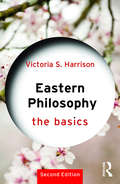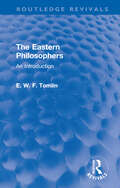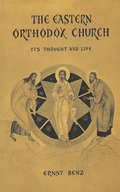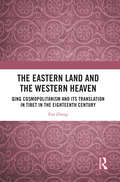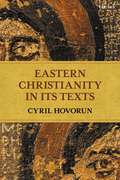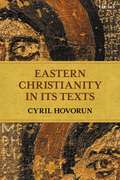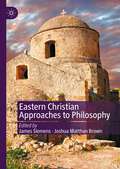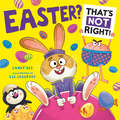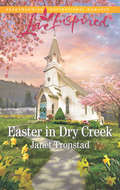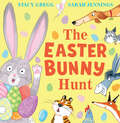- Table View
- List View
Eastern Rome and the Rise of Islam: History and Prophecy (Culture and Civilization in the Middle East)
by Olof HeiloThe emergence of Islam in the seventh century AD still polarises scholars who seek to separate religious truth from the historical reality with which it is associated. However, history and prophecy are not solely defined by positive evidence or apocalyptic truth, but by human subjects, who consider them to convey distinct messages and in turn make these messages meaningful to others. These messages are mutually interdependent, and analysed together provide new insights into history. It is by way of this concept that Olof Heilo presents the decline of the Eastern Roman Empire as a key to understanding the rise of Islam; two historical processes often perceived as distinct from one another. Eastern Rome and the Rise of Islam highlights significant convergences between Early Islam and the Late Ancient world. It suggests that Islam’s rise is a feature of a common process during which tensions between imperial ambitions and apocalyptic beliefs in Europe and the Middle East cut straight across today’s theological and political definitions. The conquests of Islam, the emergence of the caliphate, and the transformation of the Roman and Christian world are approached from both prophetic anticipations in the Ancient and Late Ancient world, and from the Medieval and Modern receptions of history. In the shadow of their narratives it becomes possible to trace the outline of a shared history of Christianity and Islam. The "Dark Ages" thus emerge not merely as a tale of sound and fury, but as an era of openness, diversity and unexpected possibilities. Approaching the rise of Islam as a historical phenomenon, this book opens new perspectives in the study of early religion and philosophy, as well as providing a valuable resource for students and scholars of Islamic Studies.
Eastern Rome and the Rise of Islam: History and Prophecy (Culture and Civilization in the Middle East)
by Olof HeiloThe emergence of Islam in the seventh century AD still polarises scholars who seek to separate religious truth from the historical reality with which it is associated. However, history and prophecy are not solely defined by positive evidence or apocalyptic truth, but by human subjects, who consider them to convey distinct messages and in turn make these messages meaningful to others. These messages are mutually interdependent, and analysed together provide new insights into history. It is by way of this concept that Olof Heilo presents the decline of the Eastern Roman Empire as a key to understanding the rise of Islam; two historical processes often perceived as distinct from one another. Eastern Rome and the Rise of Islam highlights significant convergences between Early Islam and the Late Ancient world. It suggests that Islam’s rise is a feature of a common process during which tensions between imperial ambitions and apocalyptic beliefs in Europe and the Middle East cut straight across today’s theological and political definitions. The conquests of Islam, the emergence of the caliphate, and the transformation of the Roman and Christian world are approached from both prophetic anticipations in the Ancient and Late Ancient world, and from the Medieval and Modern receptions of history. In the shadow of their narratives it becomes possible to trace the outline of a shared history of Christianity and Islam. The "Dark Ages" thus emerge not merely as a tale of sound and fury, but as an era of openness, diversity and unexpected possibilities. Approaching the rise of Islam as a historical phenomenon, this book opens new perspectives in the study of early religion and philosophy, as well as providing a valuable resource for students and scholars of Islamic Studies.
Eastern Practices and Nordic Bodies: Lived Religion, Spirituality and Healing in the Nordic Countries (Palgrave Studies in New Religions and Alternative Spiritualities)
by Daniel Enstedt Katarina PlankThis volume explores the reception, development and construction of Eastern practices in the Nordic countries. The focus is on spirituality, medicine and healing from a lived religion perspective. Besides a geographical focus on the Nordic countries and their characteristics, this collection examines the embodied practices aligned with different expressions of religiosity, alternative medicine, spirituality and healing practices. By addressing questions about how so-called Eastern practices are embodied, spread and materialized, the contributors shed light on a cultural change in Nordic societies regarding religious, spiritual and alternative health practices, that are sometimes at odds with the dominant medical discourse about life-threatening diseases and other types of conditions.
Eastern Philosophy: The Greatest Thinkers and Sages from Ancient to Modern Times
by Kevin Burns'Do not do unto others what you do not want done to yourself.'This Golden Rule of morality espoused by Confucius is just one of the many maxims that originate from Eastern philosophy. From Daoism to Islam, and from The Buddha to Zoroaster, the Eastern world contains some of the most ancient and influential approaches to philosophy that exist to date. Spanning from 1200 BCE to the present day, this fascinating guide covers a wide breadth of Eastern thinkers including Muhammad, Lao Tzu and Gandhi. These individuals and their philosophical concepts are introduced in a lively and lucid narrative with fascinating biographical detail. Packed with wisdom spanning thousands of years, Eastern Philosophy introduces some unique approaches to some of life's great questions.
Eastern Philosophy: The Basics (The Basics)
by Victoria S. HarrisonEastern Philosophy: The Basics is an essential introduction to major Indian and Chinese philosophies, both past and present. Exploring familiar metaphysical and ethical questions from the perspectives of different Eastern philosophies, including Confucianism, Daoism, and strands of Buddhism and Hinduism, this book covers key figures, issues, methods and concepts. Questions discussed include: What is the ‘self’? Is human nature inherently good or bad? How is the mind related to the world? How can you live an authentic life? What is the fundamental nature of reality? Throughout the book the relationships between Eastern Philosophy, Western Philosophy and the questions reflective people ask within the contemporary world are brought to the fore. With timelines highlighting key figures and their contributions, a list of useful websites and further reading suggestions for each topic, this engaging overview of fundamental ideas in Eastern Philosophy is valuable reading for all students of philosophy and religion, especially those seeking to understand Eastern perspectives.
Eastern Philosophy: The Basics (The Basics)
by Victoria S. HarrisonEastern Philosophy: The Basics is an essential introduction to major Indian and Chinese philosophies, both past and present. Exploring familiar metaphysical and ethical questions from the perspectives of different Eastern philosophies, including Confucianism, Daoism, and strands of Buddhism and Hinduism, this book covers key figures, issues, methods and concepts. Questions discussed include: What is the ‘self’? Is human nature inherently good or bad? How is the mind related to the world? How can you live an authentic life? What is the fundamental nature of reality? Throughout the book the relationships between Eastern Philosophy, Western Philosophy and the questions reflective people ask within the contemporary world are brought to the fore. With timelines highlighting key figures and their contributions, a list of useful websites and further reading suggestions for each topic, this engaging overview of fundamental ideas in Eastern Philosophy is valuable reading for all students of philosophy and religion, especially those seeking to understand Eastern perspectives.
Eastern Philosophy: The Basics (The Basics)
by Victoria S. HarrisonEastern Philosophy: The Basics is an essential introduction to major Indian and Chinese philosophies, both past and present. Exploring familiar metaphysical and ethical questions from the perspectives offered by a range of eastern philosophies, including Confucianism, Daoism, the main Buddhist and Hindu philosophical schools, as well as Jainism, this book covers key figures, issues, methods and concepts. Questions discussed include: What is the ‘self’? Is human nature inherently good or bad? How is the mind related to the world? How can you live an authentic life? What is the fundamental nature of reality? With timelines highlighting key figures and their contributions, a list of useful websites, pronunciation guides and further reading suggestions, Eastern Philosophy: The Basics provides an engaging overview of fundamental ideas in eastern philosophy. The second edition has been thoroughly revised and updated to take account of the most recent scholarship. It includes study questions for each chapter, an updated bibliography, a new section on the Yijing and expanded discussion of Indian philosophies and their basis in experience. Eastern Philosophy: The Basics is valuable reading for all students of philosophy and religion, especially those seeking to understand eastern thought.
Eastern Philosophy: The Basics (The Basics)
by Victoria S. HarrisonEastern Philosophy: The Basics is an essential introduction to major Indian and Chinese philosophies, both past and present. Exploring familiar metaphysical and ethical questions from the perspectives offered by a range of eastern philosophies, including Confucianism, Daoism, the main Buddhist and Hindu philosophical schools, as well as Jainism, this book covers key figures, issues, methods and concepts. Questions discussed include: What is the ‘self’? Is human nature inherently good or bad? How is the mind related to the world? How can you live an authentic life? What is the fundamental nature of reality? With timelines highlighting key figures and their contributions, a list of useful websites, pronunciation guides and further reading suggestions, Eastern Philosophy: The Basics provides an engaging overview of fundamental ideas in eastern philosophy. The second edition has been thoroughly revised and updated to take account of the most recent scholarship. It includes study questions for each chapter, an updated bibliography, a new section on the Yijing and expanded discussion of Indian philosophies and their basis in experience. Eastern Philosophy: The Basics is valuable reading for all students of philosophy and religion, especially those seeking to understand eastern thought.
The Eastern Philosophers: An Introduction (Routledge Revivals)
by E. W. TomlinFirst published in 1952, The Eastern Philosophers provides a straightforward account of the life and work of the great thinkers of the East and attempts to show, in terms intelligible to the ordinary reader, with what remarkable insistence the greatest of these thinkers dwell upon common themes. It discusses themes like Babylonia and Israel; Zoroaster; Hinduism; the Buddha and Buddhism; the Hindu systems; the Chinese Sages and Mohammed and Islam. The book raises three fundamental questions –what are the basic differences between Eastern and Western thought? What does the Western World owe it to the thought of the East and vice versa? In the third place, to what extent is a rapprochement possible between the two worlds of thought? This book is an essential read for students of Philosophy in general and Eastern Philosophy in particular.
The Eastern Philosophers: An Introduction (Routledge Revivals)
by E. W. TomlinFirst published in 1952, The Eastern Philosophers provides a straightforward account of the life and work of the great thinkers of the East and attempts to show, in terms intelligible to the ordinary reader, with what remarkable insistence the greatest of these thinkers dwell upon common themes. It discusses themes like Babylonia and Israel; Zoroaster; Hinduism; the Buddha and Buddhism; the Hindu systems; the Chinese Sages and Mohammed and Islam. The book raises three fundamental questions –what are the basic differences between Eastern and Western thought? What does the Western World owe it to the thought of the East and vice versa? In the third place, to what extent is a rapprochement possible between the two worlds of thought? This book is an essential read for students of Philosophy in general and Eastern Philosophy in particular.
Eastern Orthodox Encounters of Identity and Otherness: Values, Self-Reflection, Dialogue
by Andrii Krawchuk Thomas BremerFrom diverse international and multi-disciplinary perspectives, the contributors to this volume analyze the experiences, challenges and responses of Orthodox Churches to the foundational transformations associated with the dissolution of the USSR.
The Eastern Orthodox Church: Its Thought and Life
by Ernst BenzWestern European Christendom finds it difficult to comprehend the Eastern Orthodox Church because it knows little about the practice and doctrines of Orthodoxy. Even what is known is overlaid by many strata of prejudices and misunderstandings, partly political in nature. One of the obstacles has been the natural tendency to confound the ideas and customs of the Orthodox Church with familiar parallels in Roman Catholicism. To escape this tradition pitfall, Ernst Benz focuses on icon painting as a logical place to begin his examination of the Orthodox Church.Beginning with a brilliant discussion of the importance of icons in the Eastern Church--and the far-reaching effects of icons on doctrine as well as art--Benz counteracts the confusion, explaining simply and clearly the liturgy and sacraments, dogma, constitution and law of Eastern Orthodoxy. In brief history, he describes the rise of Orthodox national churches, schismatic churches, and churches in exile; the role of monasticism and its striking differences from Roman Catholic monasticism; the missionary work of the Orthodox Church; and the influence of Orthodoxy on politics and culture.The role of the church can be defined in terms of the image. Benz writes that the church exists so that "members may be incorporated into the image of Jesus Christ a in that individual believers are aechanged into his likeness'" as Paul writes in the second letter to the Corinthians. Thus, Orthodox theology holds up the icon as the true key to the understanding of Orthodox dogma. The Eastern Orthodox Church will be valuable to anyone interested in learning more about the church, its thought, its life, and its ideals.
The Eastern Orthodox Church: Its Thought and Life
by Ernst BenzWestern European Christendom finds it difficult to comprehend the Eastern Orthodox Church because it knows little about the practice and doctrines of Orthodoxy. Even what is known is overlaid by many strata of prejudices and misunderstandings, partly political in nature. One of the obstacles has been the natural tendency to confound the ideas and customs of the Orthodox Church with familiar parallels in Roman Catholicism. To escape this tradition pitfall, Ernst Benz focuses on icon painting as a logical place to begin his examination of the Orthodox Church.Beginning with a brilliant discussion of the importance of icons in the Eastern Church--and the far-reaching effects of icons on doctrine as well as art--Benz counteracts the confusion, explaining simply and clearly the liturgy and sacraments, dogma, constitution and law of Eastern Orthodoxy. In brief history, he describes the rise of Orthodox national churches, schismatic churches, and churches in exile; the role of monasticism and its striking differences from Roman Catholic monasticism; the missionary work of the Orthodox Church; and the influence of Orthodoxy on politics and culture.The role of the church can be defined in terms of the image. Benz writes that the church exists so that "members may be incorporated into the image of Jesus Christ a in that individual believers are aechanged into his likeness'" as Paul writes in the second letter to the Corinthians. Thus, Orthodox theology holds up the icon as the true key to the understanding of Orthodox dogma. The Eastern Orthodox Church will be valuable to anyone interested in learning more about the church, its thought, its life, and its ideals.
The Eastern Orthodox Church: A New History
by John Anthony McGuckinAn insider’s account of the Eastern Orthodox Church, from its beginning in the era of Jesus and the Apostles to the modern age In this short, accessible account of the Eastern Orthodox Church, John McGuckin begins by tackling the question "What is the Church?" His answer is a clear, historically and theologically rooted portrait of what the Church is for Orthodox Christianity and how it differs from Western Christians’ expectations. McGuckin explores the lived faith of generations, including sketches of some of the most important theological themes and individual personalities of the ancient and modern Church. He interweaves a personal approach throughout, offering to readers the experience of what it is like to enter an Orthodox church and witness its liturgy. In this astute and insightful book, he grapples with the reasons why many Western historians and societies have overlooked Orthodox Christianity and provides an important introduction to the Orthodox Church and the Eastern Christian World.
Eastern Orthodox Christianity: The Essential Texts
by Bryn Geffert Theofanis G. StavrouTwo leading academic scholars offer the first comprehensive source reader on the Eastern Orthodox church for the English-speaking world. Designed specifically for students and accessible to readers with little or no previous knowledge of theology or religious history, this essential, one-of-a-kind work frames, explores, and interprets Eastern Orthodoxy through the use of primary sources and documents. Lively introductions and short narratives that touch on anthropology, art, law, literature, music, politics, women’s studies, and a host of other areas are woven together to provide a coherent and fascinating history of the Eastern Orthodox Christian tradition.
The Eastern Land and the Western Heaven: Qing Cosmopolitanism and its Translation in Tibet in the Eighteenth Century
by Fan ZhangThis book sheds light on the structure of “a unity with diversity” developed in the Qing imperial formation (1636–1912) by a case study of the Qing-Tibetan encounters in the eighteenth century. By analyzing historical and ethnographical materials, the book investigates the translation of Chinese histories and stone inscriptions into Tibetan, the transformation of the landscapes at Mount Wutai and Lhasa, and the transplantation of Chinese deities and medical practices to Tibet. It demonstrates the processes in which the cosmopolitan interlocutors reified imperial integrity while expressing their diverse longings and belongings. It concludes that the Qing’s rule over its cultural others was neither simply Sinicizing nor colonizing, but a translational process in which multivocalic actors shared narratives, landscapes, and practices, while the emperor and tantric masters performed cosmic power over humans and metahumans. This book cuts across the fields of anthropology, history, Chinese Studies, and Tibetan Studies. It reflects on the concepts of sovereignty and ethnicity, and it also extends the methodological horizon of historical anthropology.
The Eastern Land and the Western Heaven: Qing Cosmopolitanism and its Translation in Tibet in the Eighteenth Century
by Fan ZhangThis book sheds light on the structure of “a unity with diversity” developed in the Qing imperial formation (1636–1912) by a case study of the Qing-Tibetan encounters in the eighteenth century. By analyzing historical and ethnographical materials, the book investigates the translation of Chinese histories and stone inscriptions into Tibetan, the transformation of the landscapes at Mount Wutai and Lhasa, and the transplantation of Chinese deities and medical practices to Tibet. It demonstrates the processes in which the cosmopolitan interlocutors reified imperial integrity while expressing their diverse longings and belongings. It concludes that the Qing’s rule over its cultural others was neither simply Sinicizing nor colonizing, but a translational process in which multivocalic actors shared narratives, landscapes, and practices, while the emperor and tantric masters performed cosmic power over humans and metahumans. This book cuts across the fields of anthropology, history, Chinese Studies, and Tibetan Studies. It reflects on the concepts of sovereignty and ethnicity, and it also extends the methodological horizon of historical anthropology.
The Eastern Church in the Spiritual Marketplace: American Conversions to Orthodox Christianity (NIU Series in Orthodox Christian Studies)
by Amy SlagleLike many Americans, the Eastern Orthodox converts in this study are participants in what scholars today refer to as the "spiritual marketplace" or quest culture of expanding religious diversity and individual choice-making that marks the post-World War II American religious landscape.In this highly readable ethnographic study, Slagle explores the ways in which converts, clerics, and lifelong church members use marketplace metaphors in describing and enacting their religious lives. Slagle conducted participant observation and formal semi-structured interviews in Orthodox churches in Pittsburgh, Pennsylvania, and Jackson, Mississippi. Known among Orthodox Christians as the "Holy Land" of North American Orthodoxy, Pittsburgh offers an important context for exploring the interplay of Orthodox Christianity with the mainstreams of American religious life. Slagle's second round of research in Jackson sheds light on the American Bible Belt where over the past thirty years the Orthodox Church in America has marshaled significant resources to build mission parishes.Relatively few ethnographic studies have examined Eastern Orthodox Christianity in the United States, and Slagle's book fills a significant gap. This lucidly written book is an ideal selection for courses in the sociology and anthropology of religion, contemporary Christianity, and religious change. Scholars of Orthodox Christianity, as well as clerical and lay people interested in Eastern Orthodoxy, will find this book to be of great appeal.
Eastern Christianity in Its Texts
by Cyril HovorunSurveying theological literature produced in the Christian East from the first through the 20th century, Eastern Christianity in its Texts explores different theological themes (analytical and mystical), genres (epistles, treatises, and poetry), and milieux (Greek, Armenian, Western and Eastern Syriac, Russian and Romanian). The book illustrates the evolution of the Orthodox thought, how it influenced and was influenced by intellectual, social, and political environments. It demonstrates a theology in context, and yet displays consistency in the traditions spread through different epochs and countries. The book is divided in five parts, each standing for an epoch with distinct features: formation of the Christian identity in the era before Constantine, golden age of theology in the period of Late Antiquity, the pinnacle of erudism and mysticism in the eastern Middle Ages, wrestling with the Modernity imported from the West in the 18th-19th centuries, and finally theological polyphony in the 20th century.
Eastern Christianity in Its Texts
by Cyril HovorunSurveying theological literature produced in the Christian East from the first through the 20th century, Eastern Christianity in its Texts explores different theological themes (analytical and mystical), genres (epistles, treatises, and poetry), and milieux (Greek, Armenian, Western and Eastern Syriac, Russian and Romanian). The book illustrates the evolution of the Orthodox thought, how it influenced and was influenced by intellectual, social, and political environments. It demonstrates a theology in context, and yet displays consistency in the traditions spread through different epochs and countries. The book is divided in five parts, each standing for an epoch with distinct features: formation of the Christian identity in the era before Constantine, golden age of theology in the period of Late Antiquity, the pinnacle of erudism and mysticism in the eastern Middle Ages, wrestling with the Modernity imported from the West in the 18th-19th centuries, and finally theological polyphony in the 20th century.
Eastern Christian Approaches to Philosophy
by James Siemens Joshua Matthan BrownWith few exceptions, the field of Eastern Christian studies has primarily been concerned with historical-critical analysis, hermeneutics, and sociology. For the most part it has not attempted to bring Eastern Christian philosophy into serious engagement with contemporary thought. This volume seeks to redress the matter by bringing the Eastern Christian tradition into a meaningful dialogue with contemporary philosophy. It boasts a diverse group of scholars—specialists in ancient philosophy, analytic philosophy, and continental philosophy—who engage with a wide range of pressing issues. Among other things, it addresses such topics as contemporary atheism, the metaphysics of action, religious epistemology, the philosophy of language, bioethics, the philosophy of race, and human rights. In so doing, it aims to introduce contemporary readers to unique perspectives and novel arguments often overlooked by mainstream anglophone philosophy.
Eastern Belief Systems and Classical Homeopathy: Comparative Philosophies
by Jeaneane FowlerThe many correlations between philosophical concepts in Eastern belief systems and the thought and practice of classical homeopathy have never been thoroughly explored. The homeopathy content of the arguments presented is mainly, though not exclusively, classical homeopathy, that is to say the method that emerges from the original founder, Samuel Hahnemann, and proceeds to the present day with a belief, where possible, in one, single, similimum remedy for the treatment of disease. The Eastern belief systems addressed are Hinduism, Buddhism, Taoism, and Jainism. Relevant detours include the mystical aspects of Islam as expressed in Sufism; and points of contact with Christian faith. Chapters include: Fundamental concepts The vital force The interrelated Universe Holism The pathological self Imbalance, disease and its symptoms Miasmatic pathology Remedies Potentization Cure: The purification of consciousness Homeopathy and the Coronavirus.
Easter? That’s Not Right!
by Candy BeeIt’s Easter with a twist in this hilarious mix-up of eggs with legs and hot cross BUMS…
Easter In Dry Creek: Her Secret Amish Child Easter In Dry Creek Wildfire Sweethearts (Dry Creek #17)
by Janet TronstadReclaiming the Cowgirl's Heart
The Easter Bunny Hunt
by Stacy GreggKnock-knock! Who’s at the door? Join Cat and Dog as they await the arrival of one special Easter visitor in this hilarious illustrated picture book.




